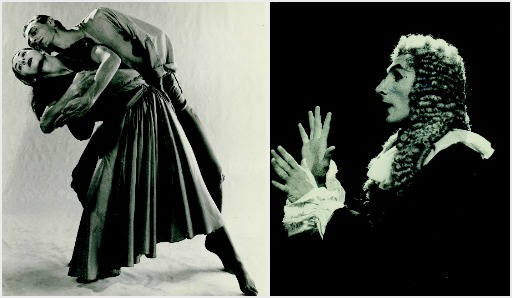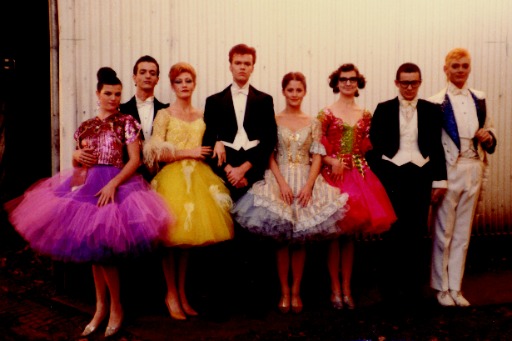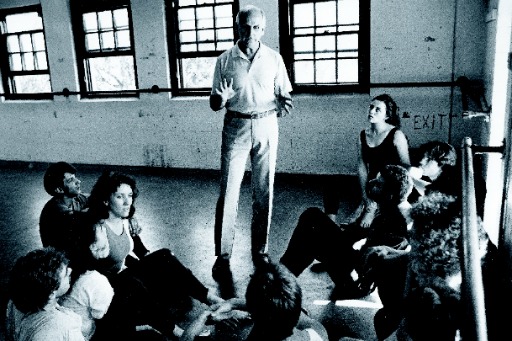Keith Bain achieved so much during his extensive and diverse career. He exerted a major influence on dance and drama in Australia through the scores of students he trained and the colleagues with whom he worked.
Born 23 November 1926, Keith grew up in Wauchope in Northern NSW with a loving family where music and dance were a part of life. His first job, at age 19 was teaching at a boy’s high school in Sydney and later he taught in the country town of Temora. He referred to himself as a country lad and returned many times to Wauchope to visit family and friends.
During his time as a teacher in Sydney he was inspired by all things theatrical, and in Temora he produced plays and musicals for the school. He was particularly inspired by the work of Gertrud Bodenwieser, a modern dance pioneer originally from Vienna and so, after eight years out in the field, he gave up school teaching to train with her. It wasn’t long before he joined and became a valuable member of her company, continuing to perform with them until she died in 1959. A solo piece for Keith was the last thing Madame Bodenwieser choreographed.
 (l) Keith Bain and Coralie Hinkley in Central Australian Suite, A Child is Born, choreographed by Madame Gertrude Bodenwieser, ABC TV 1957 Photo: Max Dupain (r) Keith Bain as the Physician in Bodenwieser's The Imaginary Invalid, 1950 (Keith Bain, private collection)
(l) Keith Bain and Coralie Hinkley in Central Australian Suite, A Child is Born, choreographed by Madame Gertrude Bodenwieser, ABC TV 1957 Photo: Max Dupain (r) Keith Bain as the Physician in Bodenwieser's The Imaginary Invalid, 1950 (Keith Bain, private collection)Wanting to keep the Bodenwieser style and philosophy alive, Keith and fellow company member, Margaret Chapple, set up the Bodenwieser Dance Centre. They also introduced new dance styles and the studio became the most popular dance training venue in Sydney.
When Keith first worked with Bodenwieser, he needed to earn money so, alike others at the time, he also trained as a ballroom teacher and became an instructor for the popular and trendy Arthur Murray Studios. He soon became dance director, staff trainer and teacher of advanced students.
 Strictly Ballroom (first incarnation) at NIDA 1984 Nell Schofield, Tony Poli, Helen Mutkins, Glenn Keenan, Sonia Todd, Catherine McClements, Baz Luhrmann, Jamie Robertson (Sonia Todd, private collection)
Strictly Ballroom (first incarnation) at NIDA 1984 Nell Schofield, Tony Poli, Helen Mutkins, Glenn Keenan, Sonia Todd, Catherine McClements, Baz Luhrmann, Jamie Robertson (Sonia Todd, private collection)In the early sixties he earned a reputation as an Australian Ballroom Exhibition Champion and Latin-American Champion. But entering the competitive world of ballroom, he and his partner, Joyce Lofts, found their dancing was very different to the traditional style expected of this genre. While audiences loved them, they confounded the judges with their unique and distinctive approach. This experience would later become the subject of the highly successful feature film Strictly Ballroom by Baz Luhrmann.
As a pioneer in many of the things he undertook, Keith’s contribution to teaching movement to actors was, perhaps, the most crucial. When he was asked by Doris Fitton in 1959 to teach at The Independent Theatre, he immediately recognised the need for a very particular approach to movement, realising that his dance skills would have to be adapted and, thus, began the long process of discovery that became his teaching method.
 Studio shot NIDA, 1974 Keith Bain (Keith Bain, private collection)
Studio shot NIDA, 1974 Keith Bain (Keith Bain, private collection)In 1965, Keith was invited to teach at the National Institute of Dramatic Arts (NIDA), a position he held for the next 40 years till 2005. As well as conducting classes, Keith also choreographed and contributed to many student productions.
At the same time, in the late 60s and early 70s, he forged the idea of movement in the emerging Australian theatre scene at The Old Tote and Jane Street theatres. Keith choreographed shows like The Legend of King O’Malley and On Our Selection and later, with the move to Nimrod, Biggles and Flash Jim Vaux. He worked with some of Australia’s best directors including John Bell, Rex Cramphorn, Gale Edwards, Aubrey Mellor, George Whaley and Richard Wherrett, among others. All came to appreciate Keith’s extraordinary contribution to their productions.
He also choreographed musicals like Jesus Christ Superstar, directed by Jim Sharman and Reg Livermore’s one-man shows as well as many of the Gilbert and Sullivan operas starring Dennis Olsen.
In the early days of television, variety shows were very popular. Keith choreographed and danced in many of these swiftly formulated productions, including The Lorrae Desmond Show as well as in commercials and other programs. He loved the challenges of doing live TV, of the constant weekly changes, often having to adapt to the studio sets and to improvise and, as always, Keith relished every moment of the intense environment.
The movement between commercial forms and the art world became a feature of Keith’s ability to understand the pervasiveness of movement for he was also instrumental in encouraging new choreographic talent in the dance world through his work with Ballet Australia and by setting up summer schools in Armidale with Dame Peggy Van Praagh, then director of The Australian Ballet.
Markedly, Keith inspired confidence. One of his first instructions in class was to “Find your true height” and indeed everyone in his presence did stand taller. He taught the students more than skills because he had a remarkable ability to make his students feel they could do anything, making them feel special and thus valued with their individual qualities.
Many of his students have since gone on to successfully grace world stages, films and television, their unique talents readily observed through a physical language that they learnt from Keith. Many of his students later became his friends and colleagues.
Keith not only taught for the Acting program at NIDA, he also established The Movement Studies postgraduate course in 1991 and, together with Avigail Herman, set up the part-time Music Theatre Course run by NIDA’s Open Program.
 Onstage at The Bolshoi Theatre after the gala performance in honour of Yuri Grigorovich, 11 Jan 11. International Theatre Institute Dance Committee: Patricia Aulestia de Alba (Mexico), Keith Bain, Kirsten Ralov (Denmark), Rolf Garske (West Germany), Yuri Grigorovich (Soviet Union), Doris Laine (Finland), Robin Howard (UK), Barry Smersky (Israel), Dietmar Seyffert (E. Germany).
Onstage at The Bolshoi Theatre after the gala performance in honour of Yuri Grigorovich, 11 Jan 11. International Theatre Institute Dance Committee: Patricia Aulestia de Alba (Mexico), Keith Bain, Kirsten Ralov (Denmark), Rolf Garske (West Germany), Yuri Grigorovich (Soviet Union), Doris Laine (Finland), Robin Howard (UK), Barry Smersky (Israel), Dietmar Seyffert (E. Germany).His unfailing vision and faith in the human potential imbued Keith with the ability to establish organizations that today we take for granted. He was instrumental in setting up the original Australia Council, Arts NSW, Ausdance and the International Theatre Institute, among others. He travelled overseas as a delegate for the International Theatre Institute and also participated as a judge at international dance competitions. It is no wonder that he established the Dancers Picnic, later to become the Australian Dance Awards.
Over the years, Keith contributed so much to the performing arts that he received the Queen Elizabeth Jubilee medal and Australian Dance Awards for both Services to Dance Education and for Lifetime Achievement. He was also the recipient of an Australian Artists Creative Fellowship and the Order of Australia medal.
Above all, Keith was a dancer, an invaluable educator and an extraordinarily generous colleague. He will be missed by many.

